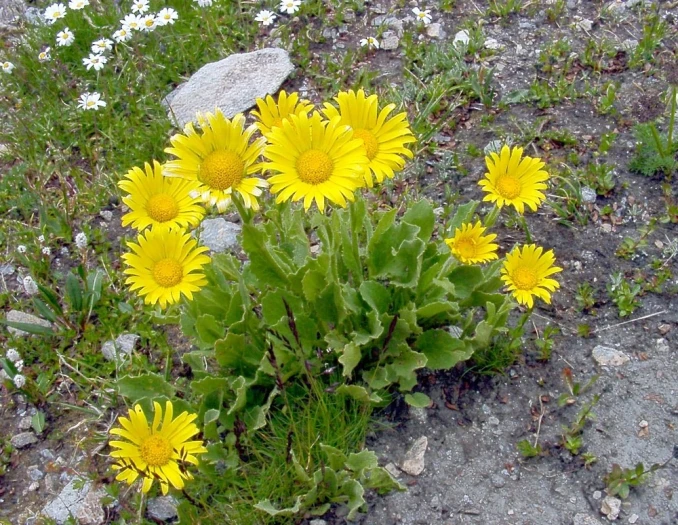Large-Flowered Leopard’s Bane
(Doronicum grandiflorum)
Large-Flowered Leopard’s Bane (Doronicum grandiflorum)
/
/

© Thierry Arbault
CC BY 4.0
Image By:
© Thierry Arbault
Recorded By:
Copyright:
CC BY 4.0
Copyright Notice:
Photo by: © Thierry Arbault | License Type: CC BY 4.0 | License URL: http://creativecommons.org/licenses/by/4.0/ | Uploader: thierrya | Publisher: iNaturalist |























Estimated Native Range
Climate Requirements for Hilo, Hawaii
| This Plant | Your Site | Plant Suitability for Your Location | ||
|---|---|---|---|---|
| • Precipitation | 9" - 93" | 111" | Aquatic | Aquatic |
| • High Temp. | 38°F - 91°F | 84°F | Your summer temperatures are normal for this plant. | Excellent |
| • Low Temp. | 4°F - 42°F | 63°F | OK, but your winter temperatures are warmer than normal for this plant | OK |
This plant may not grow well at your location - your precipitation is too high.
Summary
Doronicum grandiflorum, commonly known as Large-Flowered Leopard’s Bane, is a perennial herb native to the alpine and subalpine zones of the European mountain ranges, including the Alps, Pyrenees, and northern Balkans. It thrives in calcareous soils within limestone rubble and gravel, often found at altitudes between 4,600 to 11,200 feet. This species typically grows to a height of 4-16 inches. Doronicum grandiflorum is characterized by its bright yellow flower heads that are borne on hairy stalks above the foliage. The flowers, which consist of both ray and disc florets, are showy and bloom from July through August. The ground-level leaves are toothed, ovate, and supported by long petioles, forming a basal rosette.
In cultivation, Large-Flowered Leopard’s Bane is valued for its vibrant yellow flowers that can brighten up rock gardens, alpine collections, and border fronts. It is relatively low-maintenance, preferring well-drained soils with a neutral to alkaline pH. The plant requires moderate watering, especially in drier conditions, and benefits from full sun to partial shade exposure. While not commonly used for culinary or medicinal purposes, it is appreciated for its ornamental qualities and ability to attract pollinators. Gardeners should be aware that, although not aggressive, it can be susceptible to slug damage and may suffer from powdery mildew in humid conditions.CC BY-SA 4.0
In cultivation, Large-Flowered Leopard’s Bane is valued for its vibrant yellow flowers that can brighten up rock gardens, alpine collections, and border fronts. It is relatively low-maintenance, preferring well-drained soils with a neutral to alkaline pH. The plant requires moderate watering, especially in drier conditions, and benefits from full sun to partial shade exposure. While not commonly used for culinary or medicinal purposes, it is appreciated for its ornamental qualities and ability to attract pollinators. Gardeners should be aware that, although not aggressive, it can be susceptible to slug damage and may suffer from powdery mildew in humid conditions.CC BY-SA 4.0
Plant Description
- Plant Type: Herb
- Height: 1.5-2 feet
- Width: 1-1.5 feet
- Growth Rate: Moderate
- Flower Color: Yellow
- Flowering Season: Spring
- Leaf Retention: Deciduous
Growth Requirements
- Sun: Full Sun, Part Shade
- Water: Medium
- Drainage: Medium
Common Uses
Bee Garden, Border Plant, Butterfly Garden, Low Maintenance, Rock Garden
Natural Habitat
Native to alpine and subalpine zones of European mountain ranges, thriving in calcareous soils within limestone rubble and gravel
Other Names
Common Names: Great Leopard’s-bane, Alpine Leopard’s-bane
Scientific Names: Doronicum grandiflorum, Arnica alpina, Arnica scorpioides, Aronicum barcense, Aronicum latifolium, Aronicum scorpioides, Aronicum scorpioides, Aronicum scorpioides var. auriculatum, Aronicum scorpioides var. non-auriculatum
GBIF Accepted Name: Doronicum grandiflorum